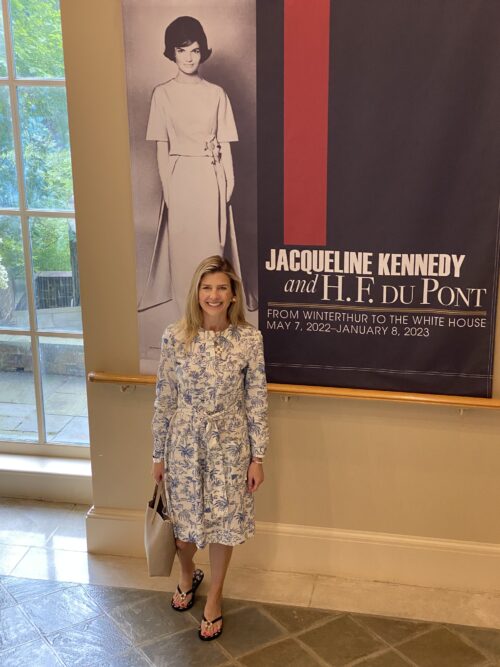
By Stuart Dyer
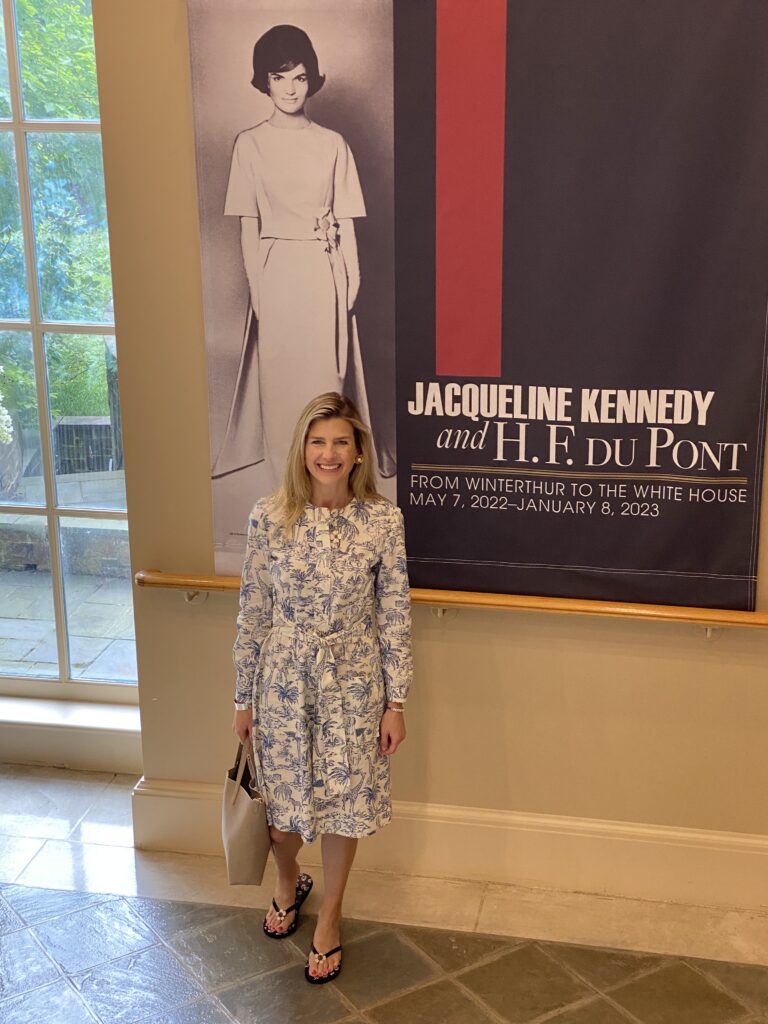
The author, Stuart Dyer at Winterthur
I recently visited one of my favorite places in Delaware, the Winterthur Museum. It is housed in the 175 room mansion that was once lived in by Henry Francis du Pont – the museum’s founder. It holds the most significant collection of American decorative arts in the world, featuring nearly 90,000 objects that were made or used in America dating back to 1640.

Portrait of Henry Francis du Pont painted in 1965 by Aaron Shikler
My visit coincided with an exhibit called “Jacqueline Kennedy and H. F. du Pont: From Winterthur to the White House”. It explores the impact that Henry Francis du Pont had on Mrs. Kennedy’s 1961 restoration of the White House. There were others who influenced the design of the restoration as well, such as interior decorator Sister Parish and most notably the French designer Stéphane Boudin but this exhibit focuses mainly on du Pont’s influence. Du Pont was in large part responsible for keeping the White House restoration on track with American decorative arts. Mrs. Kennedy was a Francophile and had a preference for all things French. Du Pont quoted saying, “I have a feeling that her (Mrs. Kennedy’s) real interest is in French things, and she does not believe that you can have a swell house with American furniture. I want her to see that you can.”

President and Mrs Kennedy with their family in 1961
Jacqueline Kennedy’s interest in renovating the White House started when she became First Lady and moved into her new home. She was surprised to find that the White House rooms were not very stately and were lacking in objects from the White House’s past. Apparently when presidents would come and go, they could just take things with them or sell them off. There was no formal policy of preservation to protect the objects in the White House or to protect the White House itself as a museum or a monument. Mrs. Kennedy didn’t feel that the White House properly reflected the legacy of America’s great leaders or that it showcased American decorative arts. There was little if any historical significance to the furnishings she found when she arrived. Mrs. Kennedy wanted to create a space where the legacy of America’s leaders was visible to the public who visited the White House and to the foreign dignitaries who were entertained there.

Mrs. Kennedy sorting through pieces from the White House collection in 1961
Mrs. Kennedy made it her mission to restore the White House however, she was not an expert in restoration or in the American decorative arts, but she was determined to bring her vision to fruition. She set about creating a committee that could help her in her endeavors. The committee was made up of scholars, curators, important interior designers, antique and art experts, and influential people of society who could help bring in money and donations.
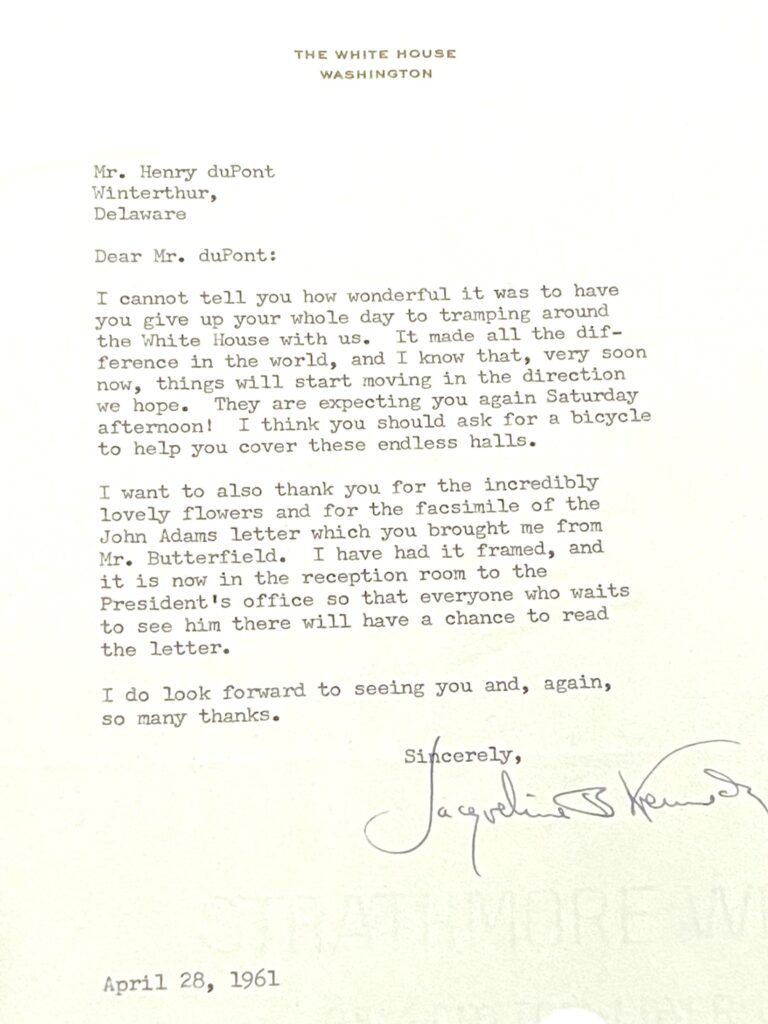
Letter from Mrs. Kennedy to Mr. du Pont to thank him for coming to the White House, April 28, 1961
The committee was named, the “Fine Arts Committee For The White House,” and Mrs. Kennedy appointed Henry Francis du Pont to lead it. At the time, Mr. du Pont was one of the most renowned scholars and collectors of American decorative arts. In 1951 he had opened the Winterthur Museum to display his vast collection. Du Pont was the ideal candidate to be the leader of the committee as he brought with him social connections, historical legitimacy and the support of a very powerful network of American antiques dealers and collectors. Du Pont accepted the position with delight. He shared Mrs. Kennedy’s vision of making the White House a symbol of cultural as well as political leadership and was eager to use the interiors to illustrate the history of the United States. Before the renovation began, du Pont was quoted as saying, “With the exception of a pair of Sheraton side chairs, the furniture in the White House is modern and very uninteresting.”

Mrs. Kennedy in the du Pont Dining Room, May 8, 1961 Photographer: Robert Hunt Whitten
On May 8, 1961 Mrs. Kennedy went to Winterthur to see the collection and to begin her education in American decorative arts. She toured the museum for hours and was in awe of the vastness of the collection. She said that it was a day never to be forgotten. In a letter that she wrote to Mr. du Pont she said, “It is marvelous that this country can produce someone like the astronaut, but I think it is much more awesome to have someone like you.”
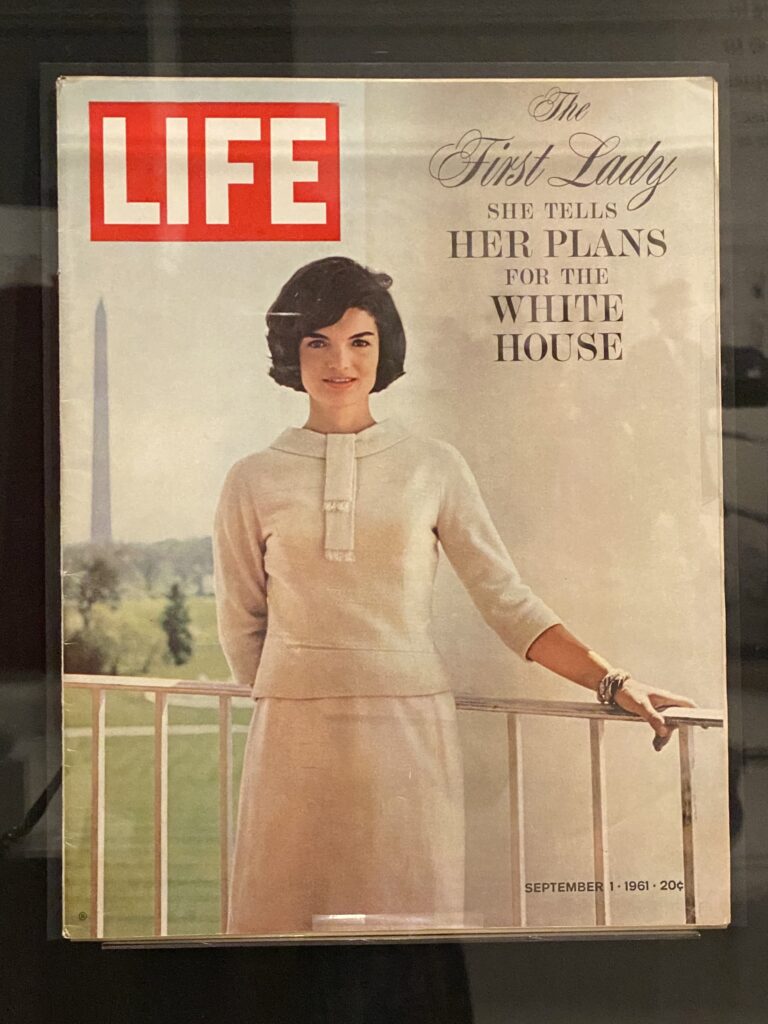
Life Magazine, September 1, 1961
The September 1961 issue of Life Magazine featured a cover article written by Hugh Sidey about Jacqueline Kennedy’s plans to renovate the White House. Mrs. Kennedy personally oversaw the preparations for the article. It featured a lot of photos and created buzz and excitement about the renovation. In the article Mrs. Kennedy is quoted as saying, “It would be sacrilege merely to redecorate it (the White House) – a word I hate. It must be restored, and that has nothing to do with decoration. That is a question of scholarship.”
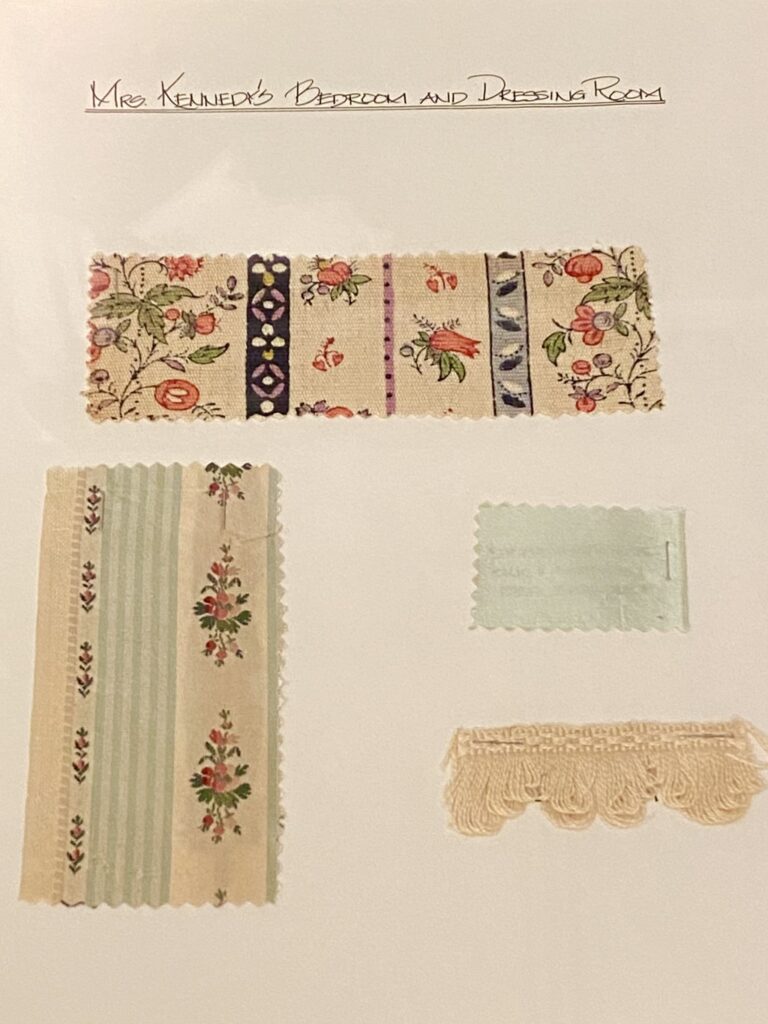
Swatch card of fabric for Mrs. Kennedy’s dressing room and bedroom made by Sister Parish
Mrs. Kennedy knew that her project would receive criticism from some and was determined to make it self-funded and self-sustaining. When the Kennedys moved into the White House, they were given $50,000 to renovate it to their taste but that money was quickly spent on the renovations to the President’s family’s private quarters, which were designed by Sister Parish. In order to renovate the rest of the White House, Mrs. Kennedy knew that she would need to raise the money privately. She was able to do this through her connections and through the connections of those on her committee. The committee decided to focus their efforts mostly on the White House’s public rooms as well as on those used by dignitaries. These rooms included The Red Room, The Green Room, The Blue Room, The State Dining Room and the Library among others.
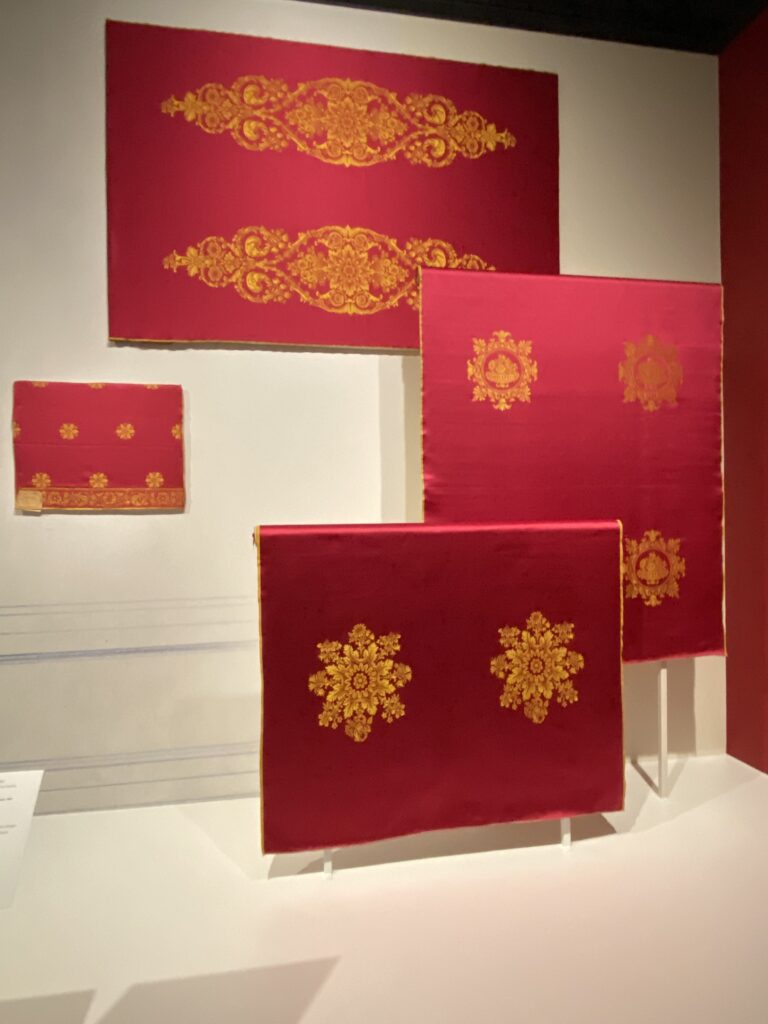
Silk fabric made by Scalamandre in 1961 for the White House’s Red Room |
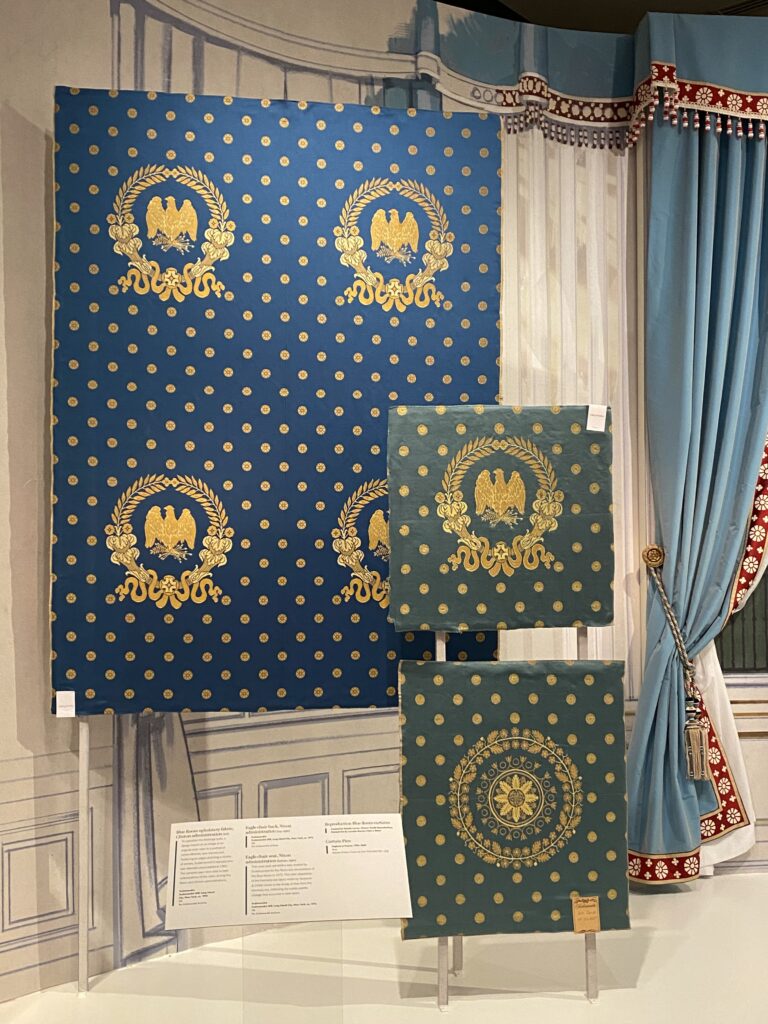
Upholstery fabric made by Scalamandre for the White House’s Blue Room |
As a culmination of Mrs. Kennedy’s renovations, CBS televised a tour of the White House on February 14, 1962. The television special was called, ‘A Tour of the White House with Mrs. John F. Kennedy’. In it Mrs. Kennedy takes CBS News correspondent Charles Collingwood through the first family’s home, highlighting the $2 million restoration project she spearheaded. Mrs. Kennedy was not given a script. She provided her own notes and only occasionally glanced at them between takes. Viewers were enthralled by Mrs. Kennedy’s confidence on camera and by her whisper-like voice. She wore a simple red suit created by the American designer, Chez Ninon based on the design of a Christian Dior suit. The television special was an unprecedented success and drew in more that 80 million viewers. Interest in touring the White House soared as did an interest in the American decorative arts.

Mrs. Kennedy with CBS correspondent, Charles Collingworth during the filming of her 1962 televised tour of the White House |

Red suit worn by Mrs. Kennedy during her 1962 televised tour of the White House, designed by Chez Ninon |
Although Mrs. Kennedy’s time in the White House was short, with help from people like Henry Francis du Pont, she was able to amass a noteworthy collection of American art and antiques and make a huge impact on how we and the world view the White House. Additionally, as a result of her work, the White House itself and the artwork and artifacts inside it are now preserved by the National Park Service and the Smithsonian Institution. Thanks to Mrs. Kennedy’s foresight, the public will be able to enjoy the White House and its treasures for generations to come.



